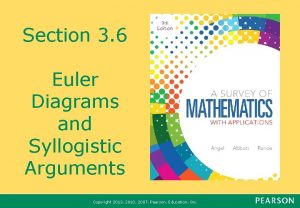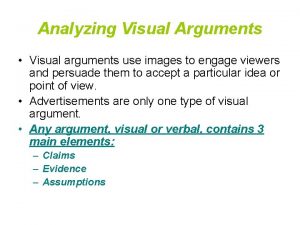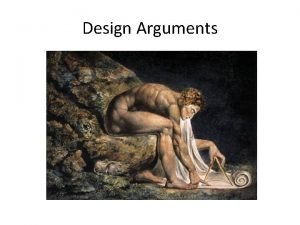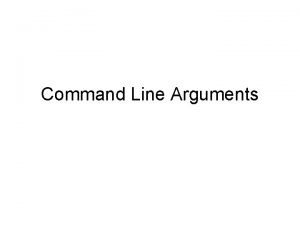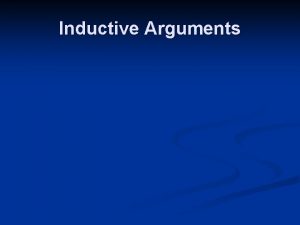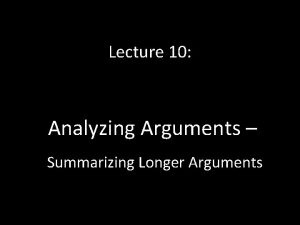1 D Analyzing Arguments with Euler Diagrams Logical








- Slides: 8

§ 1. D Analyzing Arguments with Euler Diagrams

Logical Arguments A logical argument is made up of premises (assumptions, laws, rules, observations, and widely held ideas) and a conclusion(s) (which is derived by deductive reasoning from the premises). The premises lead to a conclusion. The argument are the premises and the conclusion(s) derived from them. A valid argument is one in which when all the premises are given as true, then the conclusion(s) is also true. An invalid argument is one where when all the premises are given as true, the conclusion(s) is false. An invalid argument is called a fallacy. It is very important to understand that a valid argument may not be true. One of the following examples will show this.

Logical Arguments (Continued) Example 1: Example of a valid argument Given the following premises: Ø All mammals have two eyes Ø All dogs are mammals Ø A poodle is a dog Conclusion: A poodle has two eyes. Note: Here, we deduce the conclusion from the assumed truthfulness of the premises.

Logical Arguments (Continued) Example 2: Example of a fallacy Given the following premises: Ø All dogs have two eyes Ø All monkeys have two eyes Ø Spot has two eyes Conclusion: Spot is a dog. Note: Here, we consider that both dogs and monkeys are subsets of two eyed animals. But in fact, they are disjoint subsets of this larger universal set. So the premises lead to a false conclusion.

Logical Arguments (Continued) Example 3: Example of a valid argument that is not true! Given the following premises: Ø All flat two dimensional objects of finite extent have an edge Ø The earth is a flat two dimensional object of finite extent (of course this is false, but it was the widely held belief in the fifteenth century) Conclusion: The earth has an edge. Note: The fact that one of the two premises was in reality false has nothing to do with the argument. We accept the premises as true. The conclusion follows by deduction from the premises. So the argument is valid.

Euler Diagrams An Euler diagram (invented by the great mathematician Leonhard Euler) is a tool that helps us decide whether an argument is valid or not. It is similar to a Venn diagram using circles to represent set of objects that satisfy the given premises. An ‘x’ is used to indicate where on the diagram the conclusion falls. If it can be placed so as not to violate the premises, then the argument is valid. Otherwise the argument is a fallacy. The Euler diagram for Example 1 is: All Animals Mammals Dogs x Spot Animals with two eyes

Euler Diagrams (Continued) The Euler diagram for Example 2 is: x? Two-Eyed Animals All Animals Dogs x? Monkeys x? Here the ‘x’ represents Spot. Clearly we cannot pin the ‘x’ down to the ‘Dogs’ circle. In fact, Spot may not be an animal!

Euler Diagrams (Continued) The Euler diagram for Example 3 is: Flat 2 D objects that have an edge 2 D objects Flat 2 D objects of finite extent x Here the ‘x’ represents the earth. Thus the conclusion is valid.
